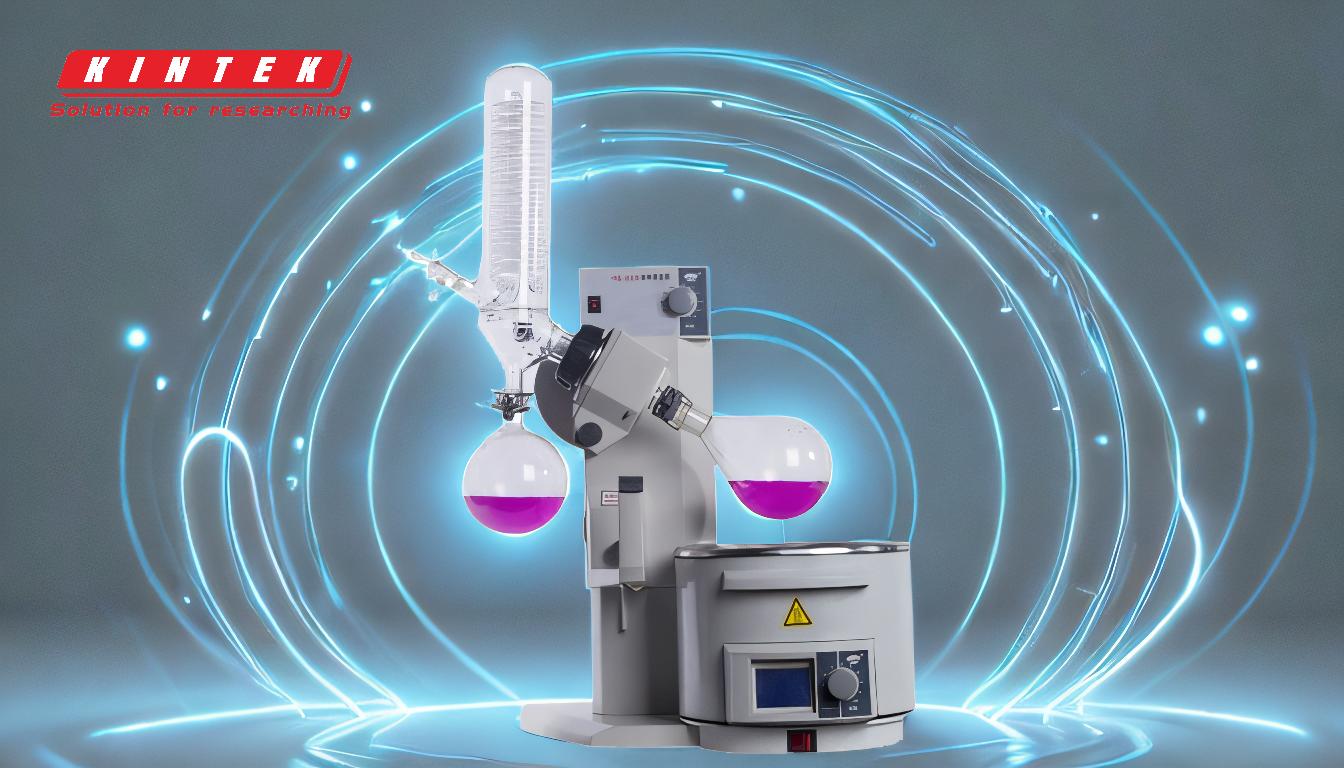A rotary evaporator (rotovap) uses a vacuum to speed up the removal of solvent from a sample by lowering the pressure within the system. This reduction in pressure decreases the boiling point of the solvent, allowing it to evaporate at a much lower temperature than it would under normal atmospheric conditions. This process not only prevents thermal degradation of heat-sensitive compounds but also enhances the efficiency and speed of solvent removal. The vacuum system, combined with the rotation of the flask, ensures uniform heating and efficient evaporation, making it a critical component of the rotary evaporation process.
Key Points Explained:

-
Pressure Reduction and Boiling Point:
- The vacuum pump reduces the pressure inside the rotary evaporator, which directly lowers the boiling point of the solvent. This is based on the principle that boiling points are pressure-dependent; as pressure decreases, so does the boiling point.
- At lower pressures, the solvent can transition from a liquid to a gas phase at a much lower temperature, reducing the need for excessive heat and minimizing the risk of damaging heat-sensitive compounds.
-
Efficiency in Solvent Removal:
- By lowering the boiling point, the vacuum system enables faster evaporation of the solvent. This is particularly useful for solvents with high boiling points, which would otherwise require prolonged heating at high temperatures.
- The process becomes more energy-efficient, as less heat is required to achieve the same rate of evaporation.
-
Prevention of Thermal Degradation:
- Many compounds, especially in pharmaceuticals, biochemistry, and organic synthesis, are sensitive to high temperatures. The vacuum system allows for solvent removal at lower temperatures, preserving the integrity of the sample.
- This is crucial for maintaining the quality and stability of the final product.
-
Enhanced Distillation Capacity:
- The vacuum system enhances the overall distillation capacity of the rotary evaporator. By creating a low-pressure environment, it ensures that the solvent is efficiently separated from the compound of interest.
- This is particularly beneficial when working with complex mixtures or when high purity is required.
-
Role of Rotation in the Process:
- The rotating flask in the rotary evaporator ensures that the sample is evenly distributed as a thin film across the inner surface of the flask. This increases the surface area exposed to the vacuum and heat, further accelerating the evaporation process.
- The rotation also prevents localized overheating, ensuring uniform evaporation and reducing the risk of bumping (sudden, violent boiling).
-
Vacuum System Components:
- The vacuum system typically includes a vacuum pump, a vacuum controller, and seals that maintain the low-pressure environment. The pump creates the vacuum, while the controller ensures precise pressure regulation.
- The seals are critical for maintaining the vacuum integrity, especially during the rotation of the flask.
-
Applications in Various Fields:
- The ability to remove solvents quickly and at low temperatures makes rotary evaporation with a vacuum system indispensable in fields such as chemistry, pharmaceuticals, food science, and environmental testing.
- It is particularly useful for concentrating solutions, purifying compounds, and recovering solvents.
-
System Pressure and Boiling Point Relationship:
- The relationship between system pressure and boiling point is codependent. By adjusting the vacuum level, users can fine-tune the boiling point to suit the specific requirements of their process.
- This flexibility allows for precise control over the evaporation process, ensuring optimal results.
In summary, the vacuum system in a rotary evaporator is essential for speeding up solvent removal by lowering the boiling point of the solvent. This not only enhances efficiency and prevents thermal degradation but also ensures the integrity and quality of the sample being processed. The combination of vacuum, rotation, and controlled heating makes rotary evaporation a powerful tool in various scientific and industrial applications.
Summary Table:
| Key Feature | Explanation |
|---|---|
| Pressure Reduction | Lowers solvent boiling point, enabling evaporation at lower temperatures. |
| Efficiency | Speeds up solvent removal, especially for high-boiling-point solvents. |
| Thermal Degradation Prevention | Protects heat-sensitive compounds by reducing evaporation temperature. |
| Distillation Capacity | Enhances separation of solvents from compounds, ensuring high purity. |
| Rotation | Ensures uniform heating and prevents localized overheating. |
| Applications | Widely used in chemistry, pharmaceuticals, food science, and environmental testing. |
Ready to enhance your lab's efficiency? Contact us today to learn more about rotary evaporators!














